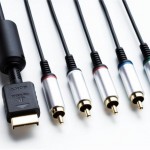Ever tried to play an upscaled DVD on your DVD or Blu-ray player through component cables? Well, unless you have one of those Asian players that the MPAA hates, then you won’t be able to, all thanks to a quirky copy protection rule that’s frankly just silly. I’ve been aware of this little bit of copy protection silliness, but it hasn’t really affected me since I use HDMI, that is until last weekend.
What happened was that my 5 year and 1 month old Pioneer plasma TV, which came with a 5 year warranty, decided (one month out of warranty for those that are paying attention) to break. Actually, everything works except for the HDMI input, and even that works except when you feed it a copy protected source. Anything that required HDCP no longer worked, and apparently this is a well known problem with early Pioneers.
Diagnosing the problem was difficult at first, because I could get my DVD player’s startup screen, but once I played a disc, everything would go black. But when playing a non commercial disc, everything worked. A little bit of brain work pointed me towards the fact that the HDCP chip for the TV had probably fried. I have a PS3 connected to this TV as well, and nothing would even show up, since Sony took the extra step of ensuring no picture at all if HDCP wasn’t enabled.
As I am in the planning stages of buying a new TV (most likely one of those Panasonic Viera plasmas, since they are now the new Kings of plasma now that Pioneer has pulled the plug), I decided it wasn’t really worth it to try and fix the problem, at least not until I’ve got my new TV. Everything would still work if I connected through component, and to be honest (and even using fairly poor quality cable), the differences were minimal. And that’s when I encountered the silliness I mentioned above.
The PS3 was connected via a new set of PS3 component cables I got (the fact that Sony only bundles composite cables with the PS3 is an insult the PS3’s HD capabilities, in my opinion – I know that most people use HDMI, but *some* people can’t and by using proprietary connectors, it makes the situation even worse). It took a while to get the picture right (see Addendum below), but once it was working, Blu-ray played great, not as good as HDMI, but hey what can you do, right?
But when it came to playing a DVD, the picture wasn’t so good. While you can watch a 1080p Blu-ray movie in 1080i (or 1080p if your TV supports that kind of thing through component), but you cannot actually watch a 576p (or 480p) DVD upscaled to 720p or 1080i, not legally anyway. Apparently, this is done to prevent copying. Except I can still copy Blu-ray movies outputted to 1080i (or 1080p). To sum up, Hollywood doesn’t want you to make copies of upscaled DVDs (ie. fake HD), but is perfectly happy for you to make copies of Blu-ray movies (ie. real HD). Does this make sense?
A little bit more brain work from me and I think I figured out why it actually does make sense, at least in the twisted logic that Hollywood employs. You see Blu-ray uses a new copy protection mechanism called AACS and as part of the specifications is something Image Constraint Token (ICT), which all Blu-ray movies carry. Basically, this allows component output to be disable or limited to lower resolutions if the studio wishes, which when activated will bring the Blu-ray situation in line with the upscaled DVD situation when it comes to output via component. In order to promote Blu-ray, manufacturers and studios came to an agreement not to implement ICT until later on, I guess they didn’t want to turn off people who had invested heavily in analogue equipment. And, this is the twisted logic part, because Blu-ray *has* the ability to prevent HD output via component (even though it wasn’t turned on), this is why Hollywood deemed it okay to allow HD output via component for now. If the DVD copy protection scheme *had* the ability to also limit HD output via component at some stage in the future, and chances are, it might have been allowed until studios realised that they have nothing to fear on this front at all. But because the DVD copy protection scheme was invented before upscaling was the norm, the sledgehammer approach was deemed the only solution, and that meant disabling all HD output via component.
There is also another set of twisted logic in play. Analogue means reduced quality, everyone knows that. So Blu-ray via analogue means the copy made is an inferior version compared to the original, which might be okay in Hollywood’s eyes. But if you take a digital standard def DVD, upscale it to high def, and then output that via analogue, and then re-digitize that, then you might end up with a copy that’s fairly close to the original. And that, in Hollywood’s eye, is not okay. Of course, anyone can just rip the DVD and retain 100% of the original quality, which is what everyone does. Just how many DVD and Blu-ray movies are actually pirated via component is quite debatable, not when there are much easier ways to make 1:1 copies. Ironically, DVD ripping may be the only way to watch your legally purchased DVDs upscaled via component, as non copy protected discs are still upscaled perfectly.

Note the two pronged PS3 Slim power cable, which probably means no more component inteference problems on the PS3
So in my situation, until I get my new TV, I’m stuck with watching DVDs in SD, while still being able to enjoy Blu-ray movies in HD glory. At least until some studio implements ICT. Luckily, this problem is largely a problem of the past, as HDMI is now far more common and comes in greater numbers of connectors on TVs than even component, and so it won’t be a problem most people will have to suffer. That is unless your TV’s HDCP chip is fried …
Addendum: I mentioned earlier about taking a while to get the picture right on my PS3 via component. The problem I ran into was the common PS3 component interference problem (horizontal or diagonal wavy lines), as described here on the official PS3 board, and luckily with solutions. My solution to the problem was to follow the information in the posted thread and remove the ground prong from the power plug, and the interference went away. This type of interference doesn’t affect the HDMI output, so that’s why I’ve never noticed it probably until now. Just why I need to do this with what is otherwise a high quality piece of electronics, I have no idea. I have never run into this problem with the dozens and dozens of low, and high quality equipment I’ve ever used, or help install for other people. And I did notice that neither the Wii nor the Xbox 360 uses the ground connector, and apparently the PS3 Slim doesn’t have it anymore either. Design fault anyone?


